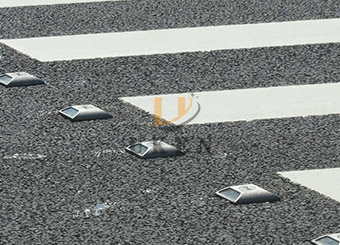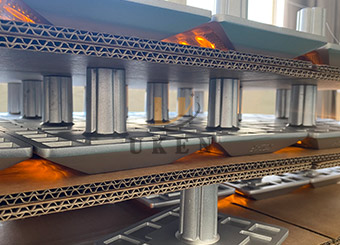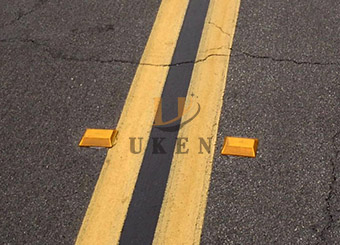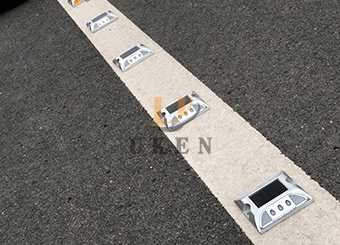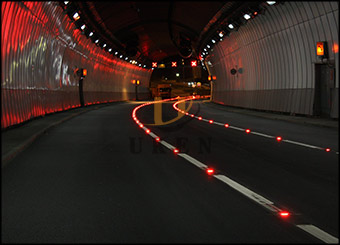Under the global trend of actively promoting energy saving and emission reduction, solar street lights are rapidly gaining popularity in the field of urban and rural road lighting by virtue of their outstanding advantages such as environmental protection, energy saving and convenient installation. Whether it is the main road in the busy city or the quiet countryside, solar street lights are lighting up the way for people. Behind this booming development, the pole, as a key component of the solar street light, plays an indispensable role, directly related to the performance and stability of the street light.
Main support structure: the main part of the solar street light pole, usually made of steel or aluminium alloy. It has various forms, such as conical and cylindrical. Taking the steel pole as an example, the sturdy steel extends upwards from the bottom, bearing the full weight of the lamps, solar panels and other components. The thick, tapered design, which gradually narrows upwards, effectively enhances stability and keeps it standing in the face of wind and rain. The cylindrical pole, with its simple and smooth appearance, provides support while displaying a unique aesthetic.
Key connecting parts:The connecting parts between the pole and the lamps and solar panels are crucial. For example, the commonly used stainless steel hoop tightly secures the luminaire to the pole, ensuring that the luminaire will not sway in the wind and rain. The connectors are responsible for mounting the solar panels on the pole in a suitable position. At the same time, these connectors are also responsible for the transmission of electricity to ensure that the electricity generated by the solar panels can be smoothly transmitted to the lamps and lanterns to realise the lighting function.
Foundation Fixing Part: The connection between the bottom of the pole and the ground foundation is the key to ensure its safe standing. Ground bolts are deeply embedded in the concrete foundation to securely fix the pole to the ground. The size and depth of the concrete foundation will be designed according to the height of the pole, local geological conditions and wind conditions. In windy areas, a deeper and larger concrete foundation will enhance the wind resistance of the pole and ensure that the pole can work stably even in bad weather.
Carrying Function:The primary function of the pole is to carry loads. During the day, solar panels are mounted on the pole, absorbing solar energy and converting it into electricity which is stored in the battery. At night, the lamps rely on the support of the pole to provide illumination for the road. In severe weather conditions such as storms and snowstorms, the pole, with its own strength and stability, ensures that the solar panels and lamps are always in a stable position, ensuring that the street light system continues to operate normally.
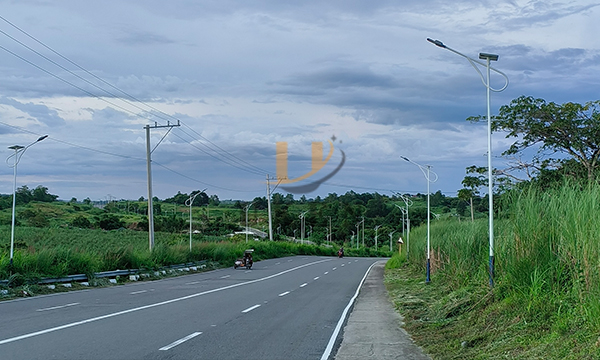
Transmission Function:Some of the light poles are equipped with a special line channel inside. The electricity generated from the solar panels is transmitted to the batteries for storage through this channel, and when night falls, the electricity in the batteries is transmitted to the lamps through this channel to realise lighting. The line channel not only protects the line from the erosion of the external environment, such as rain soaking, wind and sun, but also ensures the stable transmission of electricity, avoiding the failure of street lamps due to line problems.
City road lighting:On the main road in the city, the traffic flow is large, the speed is fast, and the requirements for road lighting are extremely high. The solar street light pole supports the high brightness lamps and lanterns, sprinkling the light evenly on the road, providing a clear vision for vehicles and pedestrians, and guaranteeing the safety of travelling at night. For example, at intersections with heavy traffic, the street lights on the poles illuminate all directions, enabling drivers to accurately judge the road conditions, effectively maintain traffic order and reduce traffic accidents, as well as adding vitality to the city at night.
Rural road lighting: In rural areas, solar street light poles also play an important role. Relatively low light poles, arranged at appropriate spacing on both sides of the countryside roads, provide convenience for villagers travelling at night. This not only improves the night travelling conditions in the countryside, but also promotes the development of night-time economic activities in the countryside, such as the night transport of agricultural products has become safer and smoother, injecting a new impetus for rural development.
Traffic guidance warning: many solar street light poles are installed with reflective signs or warning lights. At night or in fog, rainstorms and other adverse weather conditions, the vehicle’s light irradiated reflective signs, will produce a strong reflection, clearly outline the road boundaries, curves and intersections and other important locations, to remind drivers to get ready in advance to protect traffic safety. The flashing warning lights, in some dangerous road sections, such as sharp turns, steep slopes, etc., can be more eye-catching to attract the attention of the driver, reduce the risk of accidents.
Special area warning:In schools, hospitals and other special areas, solar street light poles carry a special mission. In the vicinity of schools, the lighting facilities and signs on the light poles remind drivers to slow down and pay attention to the access of students. In the vicinity of hospitals, soft and bright lights not only provide convenience for patients and their families, but also create a quiet and comfortable environment. In the construction section, the warning lights and signs on the light poles clearly delineate the construction area, guide vehicles around, and protect the safety of construction workers and passing vehicles.
Integration with the surrounding environment: The design of solar street light poles pays great attention to the integration with the surrounding environment. In the historical and cultural district, the retro-shaped light poles with traditional-style lamps complement the old buildings, as if through time and space, adding a strong historical and cultural atmosphere to the neighbourhood. In the park, the use of wood texture light poles, integrated with the natural landscape, so that visitors can enjoy the lighting at the same time, but also better feel the charm of nature.
Enhance the aesthetics of the area:Uniquely shaped light poles, such as artistically modelled light poles, have become a highlight of many cities and villages to enhance the aesthetics of the area. These poles mimic local cultural elements or modern art styles, and not only serve the function of lighting, but also become part of the landscape of the area. They attract the attention of residents and tourists, adding a unique charm to the region and enhancing the overall image and appeal.
The different types of solar street light poles
Steel light poles:Steel light poles are favoured for their high strength and good toughness. Especially in scenes that require tall poles, such as highways and city trunk roads, steel poles can easily withstand large winds and the weight of the lamps. The application of the hot-dip galvanising process provides steel light poles with a layer of ‘protective armour’. By immersing the steel in molten zinc, a zinc-iron alloy layer is formed on the surface, effectively insulating it from oxygen and moisture and greatly improving the corrosion resistance of the light pole. Different models of steel, performance varies. Q235 steel is relatively affordable, with a certain degree of strength and toughness, suitable for general road lighting; while Q345 steel is stronger, and performs well in coastal windy areas and other environments with high strength requirements.
Aluminium alloy light pole: the biggest feature of aluminium alloy light pole is light weight and corrosion resistance. In areas where the weight of the pole is required, such as the renovation of old districts, aluminium alloy light poles are more convenient to install and maintain. The surface will naturally form a dense protective film of aluminium oxide, which can effectively prevent oxygen from further reacting with the internal metal, thus providing excellent corrosion resistance. Aluminium alloys have different alloy compositions, which also affect their performance. For example, aluminium alloys containing magnesium have better corrosion resistance and can maintain good performance for a long time in wet environments.
Stainless steel light poles:Stainless steel light poles have excellent corrosion resistance and perform particularly well in highly corrosive environments such as industrially contaminated areas and seashores. The common 304 stainless steel is suitable for most general environment street light installation, while 316 stainless steel due to the addition of molybdenum element, its corrosion resistance is further enhanced, especially suitable for use in coastal areas with high salinity. However, the cost of stainless steel light poles is relatively high, but in the long term, due to its low maintenance costs, the overall price/performance ratio is still advantageous.
Low-height light poles: Low-height light poles are generally between 2 – 4 metres in height, and are mainly used in the internal roads of the community, courtyards and park trails and other places. These places have a relatively small flow of people, and the requirements for light intensity and range are relatively low. Low-height poles provide localised, soft lighting to create a warm, comfortable atmosphere and ensure safe walking at night.
Medium-height poles: Medium-height poles range from 4 – 8 metres in height and are commonly used on secondary roads in cities and towns. This height can meet the lighting needs of general roads, taking into account the lighting range and brightness. On secondary roads in cities, street lights supported by medium-height poles provide good lighting conditions for vehicles and pedestrians, ensuring normal traffic flow.
High-height poles: High-height poles are usually more than 8 metres high and are mainly used in open areas such as motorways, city trunk roads and large squares. In these places, the traffic flow is large, fast, need large area, high brightness lighting. High-height light poles can raise the lamps and solar panels to a sufficient height so that the light can cover a wider area, ensuring that drivers can clearly see the road situation from a distance, to ensure traffic safety.
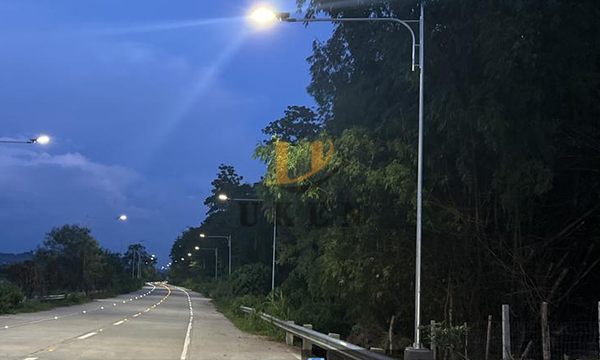
Tapered poles: Tapered poles have a larger diameter at the bottom and a smaller diameter at the top, and this unique structural design gives them excellent stability. In windy areas, such as coastal roads, conical light poles can better withstand strong winds. Its ease of installation for deep burial further enhances wind resistance and ensures that the street light can still work properly under adverse weather conditions.
Cylindrical light pole:Cylindrical light poles are simple and generous in appearance, with smooth lines, and are widely used in places that require high aesthetics, such as commercial pedestrian streets and landscape avenues. It not only has advantages in appearance, but also relatively easy to install and maintain. At the same time, the cylindrical light pole can be matched with a variety of lamps and solar panels to meet different design requirements.
Collapsible Pole:Collapsible poles offer great convenience in terms of transport and installation. In temporary lighting projects, such as temporary lighting for large event venues or temporary lighting for road construction, the collapsible pole can be easily stored and moved. When in use, just simply unfold and fix, can be quickly put into use, but also convenient for secondary use, reducing costs.
The choice of solar street light pole considerations
Climatic conditions:Different climatic conditions have different requirements for the pole material. In high temperature and rainy areas, high air humidity, frequent rain, aluminium alloy or stainless steel poles are more resistant to corrosion, is the ideal choice. In cold regions, need to consider the performance of the light pole in low temperature environment, to ensure that the material will not crack or brittle at low temperatures. In windy areas, in addition to selecting wind-resistant conical light poles, but also need to use high-strength materials to protect the stability of the light pole.
Geography:If the project is located in mountainous, hilly and other areas with complex terrain, the ease of installation of the light pole is particularly important. Lightweight, detachable design light poles are easier to transport and install in these areas. In coastal areas, where the high salt content in the air is highly corrosive to the light poles, 316 stainless steel or high quality aluminium alloy light poles with excellent corrosion resistance are the best choice.
Characteristics of the lighting area:The characteristics of the lighting area determine the height and spacing of the light poles. Main roads have high traffic flow and fast speed, requiring high brightness and wide range of lighting, so the height of light poles is generally 8 – 12 metres, with a spacing of 30 – 50 metres. The community road lighting needs are relatively low, pole height in 4 – 6 metres, spacing 15 – 20 metres can meet the demand. Accurately grasp the characteristics of the lighting area, to ensure that the street lamp to provide the right lighting effect.
Parameters of lamps and solar panels: The power and luminous angle of the lamps, as well as the size and power of the solar panels, directly affect the choice of pole. Higher power luminaires require higher and more stable poles to support them to ensure safety. Larger solar panels require a suitable mounting structure for the pole to ensure that the solar panels are able to receive sufficient sunlight to optimise power generation and ensure overall stability.
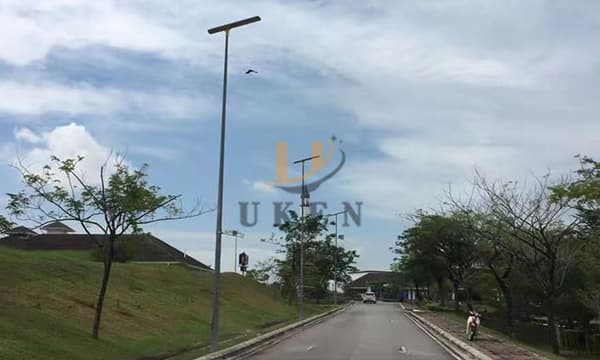
Initial Purchase Costs: Prices vary greatly depending on the material, height and structure of the pole. Steel poles are relatively low cost, while stainless steel and aluminium alloy poles are more expensive. High-height, complex structures usually cost more than low-height, simple structures. In the case of limited project budget, it is necessary to choose an affordable light pole under the premise of quality assurance. For example, for general rural road lighting projects, steel poles may be a more appropriate choice.
Long-term maintenance costs:The long-term maintenance costs of light poles should not be overlooked. Steel poles may require regular corrosion maintenance, whereas aluminium and stainless steel poles are relatively low maintenance. In addition, light poles with replaceable parts can be easily replaced when the parts are damaged, reducing long-term maintenance costs. When selecting a pole, the initial purchase cost and long-term maintenance cost need to be considered in order to maximise cost-effectiveness.
Installation Convenience:The assembly method of the light pole has a great influence on the installation convenience. Bolted light poles can be disassembled into multiple parts during transport for easy handling, and no professional welding equipment is required for installation, making them simple to operate and suitable for large-scale project installation. Lightweight poles and poles with detachable design are more convenient to install in narrow spaces or complex terrains, which can greatly improve the installation efficiency and shorten the construction period.
Convenience of Maintenance:Choosing poles with easy-to-clean surface treatments, such as plastic spraying or baking paint treatment, can reduce the maintenance workload. Plastic sprayed surface is resistant to abrasion, dust and stains are not easy to adhere to, it is more convenient to clean. Light poles with replaceable parts, such as lampshade, connectors, etc., can be replaced in a timely manner when the parts are damaged, reducing the difficulty and cost of maintenance, and ensuring that the street lamps can run stably for a long time.
This paper provides a comprehensive introduction to solar street light poles, starting from its definition, describes the use, type and a variety of factors to consider when choosing. The material, height, structural design and other aspects of the pole are interrelated, and must be weighed comprehensively when choosing. Only by fully considering the project environment, lighting needs, cost budget and ease of installation and maintenance can the most suitable pole be selected to meet the needs of the project.
